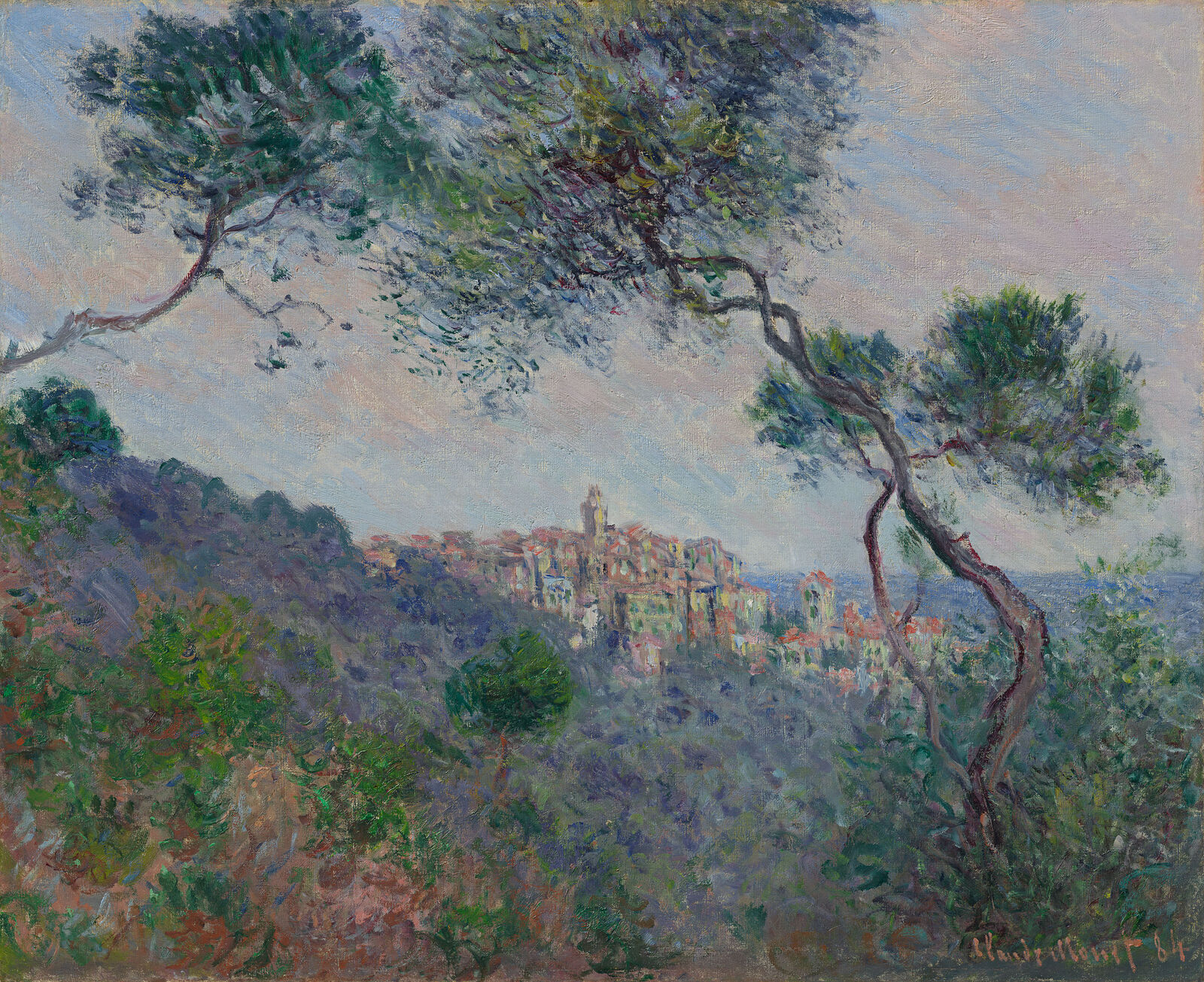Claude Monet
Bordighera, Italy, 1884
On view
39 further works by Monet
Copy link
Oil on canvas, 60 x 73 cm
Signed and dated lower right: Claude Monet 84
Inv.-no. MB-Mon-13
Claude Monet experimented with the cropping techniques of photography. In the 19th century, photographers were already marketing the landscape of the Italian coast as paesaggio italiano on a massive scale. They had also established the popular device of framing the landscape view with pine trees. Following Monet, many painters traveled to the Mediterranean. Paul Signac and Henri-Edmond Cross settled there permanently in the early 1890s.
After Monet settled in Giverny in 1883, he repeatedly embarked upon painting excursions for weeks at a time to expand his repertoire of motifs. He strategically chose aspiring tourist regions, where recognizable motifs would make his paintings easier to sell. One of his most important journeys during these years led him to the Italian coastal city of Bordighera in early 1884, where he painted over 30 medium-sized images of the southern landscape en plein air between January 18 and April 6. He had discovered the region the previous year during a trip with Pierre-Auguste Renoir, and shortly after his return to Giverny he decided to go back again by himself for a longer stay.
In letters to his companion Alice, Monet documented his progress, and emphasized that in between open air studies he was spending every free moment searching for motifs in and around Bordighera. Since Monet always depicted the topography of the landscape with great precision, the search for perspectives and angles of view suitable for the creation of a visually appealing picture was a central aspect of his work. This composition was painted from the slope of the hill Collina dei Mostaccini to the west of Bordighera, which offered a view of the old city and the sea behind it. The silhouette of the stone buildings with their glowing red tile roofs is framed by the undulating trunks of two pine trees rendered in powerful tones of green and unmixed black. In the glistening light of the south, the vegetation in the middle ground is veiled in a violet-colored haze, while the sky is depicted in light pink tones.
The painting from the Hasso Plattner Collection belongs to a group of 21 pictures from Bordighera which were purchased en bloc by the art dealer Paul Durand-Ruel in June 1884 for the impressive sum of 18,300 francs. In the four-volume catalogue raisonné of Monet’s paintings compiled by Daniel Wildenstein, Bordighera, Italy is listed as no. 852 (vol. 2, 318–19). Two closely related works that also show the town of Bordighera from the Collina dei Mostaccini are now in the Armand Hammer Museum in Los Angeles (no. 853) and the Art Institute of Chicago (no. 854).
Daniel Zamani
Monet, Galerie Bernheim-Jeune, Paris, January 21–February 2, 1921, no. 15
Impressionism: The Hasso Plattner Collection, Museum Barberini, Potsdam, from September 5, 2020
Monet en pleine lumière, Grimaldi Forum, Monaco, July 8–September 3, 2023, no. 75
June 1884, Galerie Durand-Ruel,
Paris, purchased from the artist
1890, Coquelin, Paris
May 20, 1893, Galerie Georges Petit, Paris, Coquelin Collection, lot 47
n.d., probably Sam Salz, New York
n.d., The Kimball Collection, Chicago
ca. 1962, Mr. and Mrs. André Meyer, USA
probably 1979, Private collection
January 2020, purchased from a private collection
Georges Grappe, Claude Monet, Paris 1909, ill. p. 58
Arsène Alexandre, Cl. Monet, Paris 1921, ill. p. 82
Florent Fels, Cl. Monet, Paris 1925, ill. p. 51
Lionello Venturi, Les Archives de l’Impressionnisme, Paris/New York 1939, p. 281
Daniel Wildenstein, Claude Monet: Biographie et catalogue raisonné, vol. 2, Lausanne 1979, no. 852, p. 114, 235, ill. p. 115
Robert Gordin and Andrew Forge, Monet, New York 1983, ill. p. 110
Daniel Wildenstein, Claude Monet: Biographie et catalogue raisonné, vol. 5, Lausanne 1991, p. 41
Daniel Wildenstein, Monet: Catalogue Raisonné. Werkverzeichnis, vol. 2, Cologne 1996, no. 852, p. 318/19, ill. p. 317
Do you have suggestions or questions?
sammlung@museum-barberini.de.

